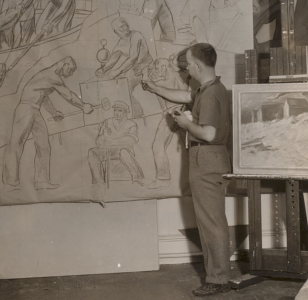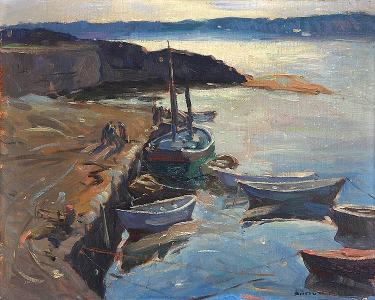

Biography
Samuel Franklin Hershey was born in Peru, IN in 1904 after his parents had temporarily moved there from Waynesboro, PA. Samuel attended Mercersburg Academy in Mercersburg, PA. He studied architecture for a year at the Massachusetts Institute of Technology and then studied art at the Grand Central School of Art in New York, the Boston Museum School of Art, and the Pennsylvania Academy of the Fine Arts in Philadelphia. He was a member of the New Haven Paint & Clay Club, where he studied with Aldro Hibbard and Lester Stevens.
In 1923 Hershey moved to Rockport, MA, where he ran the Sandy Bay Art School with Stanley Woodward and painted murals in the Cape Ann area. In 1934 he married a Rockport native Eleanor Weber, with whom he had two daughters, Susan and Deborah. In 1932 his painting "October Afternoon" was awarded the John I.H. Downes Landscape Prize by the New Haven Paint & Clay Club. Hershey was part of several WPA projects in the 1930s. Hershey, Maurice Compris and W. Lester Stevens, were hired by the Federal Art Project (FAP) to decorate the Tewksbury (MA) Hospital with themes of industrial and agricultural work. Hershey's mural dealt with quarries and factory work. In 1936 he painted three murals for the Rockport Town Hall, since demolished.
Hershey painted another FAP-sponsored mural in 1939, this one for the Rockport Public Library with the theme "Rockport Goes to War." The Treasury Department's Section of Fine Art sponsored the mural that Hershey painted for the Cambridge City, IN Post Office in 1941; it was titled "Pride of Cambridge City" and featured, over the objections of Section personnel, a famous local racehorse.
Hershey was a member of the New Haven Paint & Clay Club from 1933-1949 and exhibited his still lifes, landscapes and figure studies at the Club. But, with a family to support and general disillusionment with the business side of the art world, he turned to teaching as a primary career. He taught in the Smith College Graduate School of Architecture; he was an instructor at the Cambridge School of Architecture and Landscape Architecture from 1934-1942; and he taught at the Harvard Graduate School of Design from 1937-1942.
Following an interlude where he served as a captain in the Air Force working on a camouflage project, Hershey joined the faculty of the Rhode Island School of Design, where he taught from 1946-1969. In 1959 he helped found the School's European Honors Program, and he served as Dean of the Faculty from 1964-1969.
From 1969-1971 Hershey served as Chairman of the Department of Design at the University of California at Berkeley, retiring in 1971. He died in Gloucester, MA in 1987.



Critical Analysis
Samuel Hershey had to choose from four possible careers. The first was architecture, which he rejected, but which provided him with training that served him well for future employment. The second was painting, which was perhaps his first love. But, as his wife liked to quote, he felt that "Art is a jealous mistress," and he couldn't imagine trying to paint while working at some other job. This led him to his third choice, which was teaching. He enjoyed that immensely, particularly the one-on-one relation he had with his art students. But success in that area nudged him in the direction of a fourth career, that of arts management. While he did serve as Dean of the Faculty at the Rhode Island School of Design and was hired as Chairman of the Department of Design at Berkeley, administration was not something he particularly loved to do, especially insofar as it removed him from more direction interactions with students.
Hershey's daughter Susan described him as "bitter" for not being able to devote more time to painting. And his wife regretted that he had not turned back to full-time painting after his retirement, although his health might have precluded that option. As a result, we do not have a lot of material from which to judge Hershey's artistic career. His murals are solid compositions, perhaps influenced a bit by his study of architecture. The style in these works involves heavy outlines of the figures in the painting, which creates a dramatic effect. His easel painting are more subtle and reveal a definite talent for portraiture. We must share his family's regret that he wasn't able to paint more, since it's likely he would have produced a body of truly marvelous works.
Murals
- Cambridge City, Indiana - Post Office: Pride of Cambridge City
- Rockport, Massachusetts - Public Library: Rockport Goes to War
References
- Biography of Samuel Franklin Hershey (1904-1987) (Artprice).
- Happy Birthday to CAM artist Samuel Hershey, Cape Ann Museum August 10 (2019).
- Samuel F. Hershey (Vose Galleries).
- Samuel F. Hershey (Cape Ann Museum).
- Samuel Hershey (askART).